< Previous
The Royalist Badges of Charles I.
By Frank E. Burton, J.P.
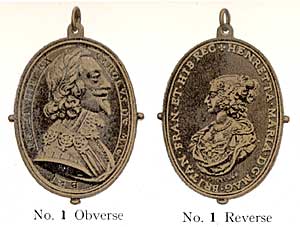
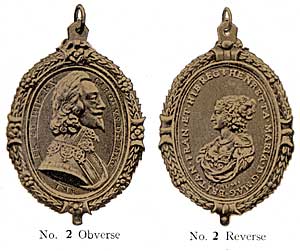
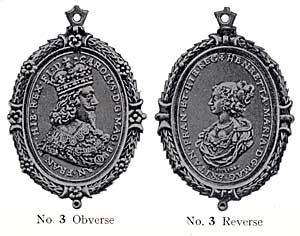
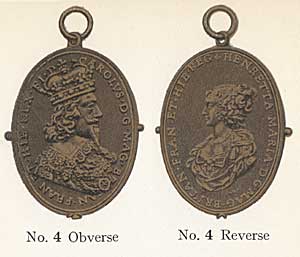
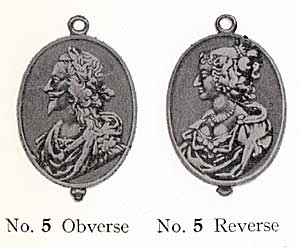
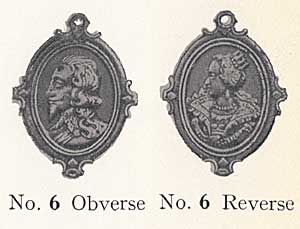

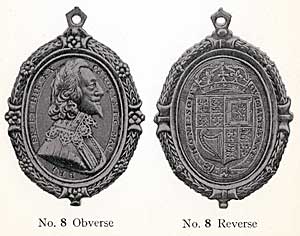
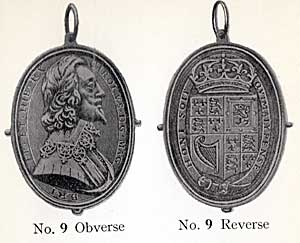
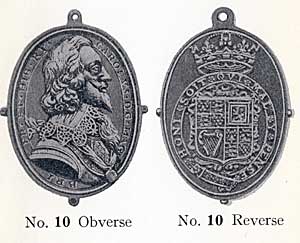
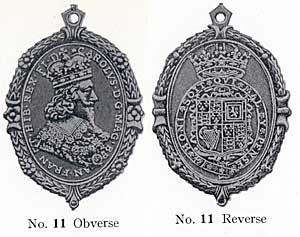
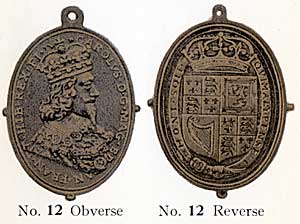
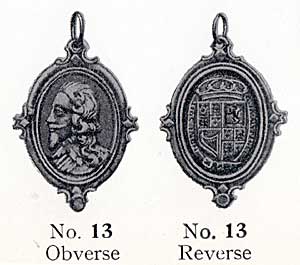
Much has been written concerning the association of King Charles I. with the City of Nottingham and the County of Nottinghamshire. Therefore these Royalist Badges are of some interest in connection with our local history.
In all probability when Charles raised his standard in Nottingham in 1642, some of his principal adherents would be in possession of these badges, and wore them openly to show their loyalty to their sovereign.
The earliest badges issued by any English Monarch were those by Queen Elizabeth. These were bestowed as rewards for great and special services rendered to the state, and very few are in existence to-day. It is extremely probable that the first badges struck by order of Charles were given for military valour. Afterwards he bestowed them for special services, and then they were given away freely to his soldiers and adherents to keep alive the Royalist cause.
From the illustrations produced from some of the badges in my possession, you will see that many of them are beautiful portraits of extremely fine work. They would be costly to produce, and were therefore only given in special cases. The smaller ones are nothing like so fine in design or workmanship, and were more widely distributed. All are of silver or silver gilt. Smaller ones were struck in lead and pewter for the common soldiers, but these being of no intrinsic value have practically disappeared.
There has been considerable doubt as to the date when these were first struck. The one numbered 10, which is dated 1642, clearly shows that they were being struck in this year. It is on record that Charles ordered a special badge to be made for Sir Robert Welch Knight, for the rescue of the Standards of the King's Own Regiment at the battle of Edge Hill, October 23rd, 1642. There are no records extant of any being given before this date. This dated Royalist Badge is extremely uncommon. From .this badge we may infer that all the badges were issued between the years 1640 and 1648, and most of the larger ones were the work of the Medallist Rawlins, some bearing his name. He was born in 1610, died 1670. He was appointed engraver to Charles the First in 1643.
The smaller ones would be by inferior artists.
1.—Gilt. Incuse obverse legend CAROLVS D.G. MAG. BRI.FR.E.T HIB. RX. Bare-headed bust of Charles I. in profile to right, lace collar, doublet, scarf across breast.
Reverse—HENRETTA. MARIA. D.G. MAG. BRITAN. FRAN. ET.HIB. REG; Bust of the Queen Henrietta Maria to left; below T. RAWLINS. Loop and ring for wearing.
2—Gilt. Same as number 1, but with wreath border, Loop and ring.
3.—Silver. Obverse. Crowned bust of Charles I. to right, lace collar, robes, collar and George of the Garter. CAROLVS. D.G. MAG. BR(IT)AN. FRAN. ET. HIB.REX.FI.D.
Reverse—Bust of the Queen, etc., same as preceding. Wreath and loop for wearing.
4.—Gilt. Same as number 3.
5.—Silver. Obverse. No legends. Laureate bust of Charles I. to left, in armour with lion's head on shoulder, chain with medal, mantle across breast.
Reverse—Bust of the Queen. Loop for suspension.
6.—Silver. Obverse. No legends. Bust of Charles I. to left, lovelock on shoulder, lace collar, armour, scarf.
Reverse—The Queen wearing medici collar. Loop for suspension.
7.—Gilt. Obverse. No legends. Bust of Charles I. to right, lovelock, armour, scarf, Riband with medal. Floral border.
Reverse—Bust of the Queen. Floral Border.
8.—Silver. Obverse. Incuse legend. CAROLVS. D.G. MAG.BRI.FR.ET.HIB.RX. Bare-headed Bust of Charles I. in profile to right, lace collar, doublet, scarf across breast.
Reverse—Incuse-Royal arms, crowned, within the Garter. Wreath border. Loop for wearing.
9.—Silver. Same design as number 8 but without wreath border.
10. Silver. Similar general design to number 8, but with
lovelock on left shoulder, and medal attached to riband, and reverse with date 1642 on the buckle of the Garter.
11.—Silver. Obverse. Crowned Bust of Charles I. to right, lace collar, robes, collar and George of the Garter.
Reverse—Royal arms, crowned, within the Garter. Wreath border. Loop for wearing.
12.—Gilt. Similar type to 11, but without wreath border.
13.—Silver. Obverse. No legends. Bust of Charles I. to left, lovelock on shoulder, lace collar, armour, scarf.
Reverse—Incuse. Royal arms, crowned, within the Garter. Loop and ring.
< Previous
